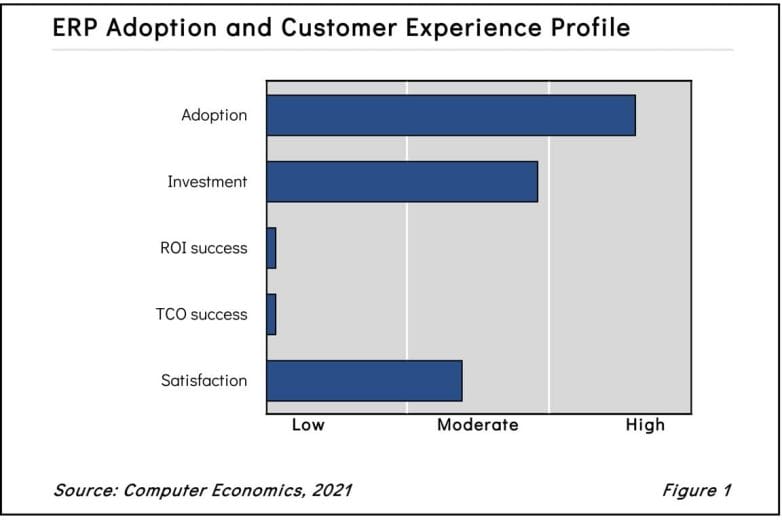Enterprise resource planning (ERP) systems have long been one of the most adopted and mature technologies that we track, and investment in new ERP capabilities remains high. But ERP systems are complicated to deploy, and many organizations have difficulty staying within budget.
Figure 1 from our full report, ERP Adoption Trends and Customer Experience, shows how ERP compares with 14 other technology initiatives in our study on five metrics: adoption rate, investment rate, ROI success rate, TCO success rate, and satisfaction. The comparisons are on a relative scale, and each technology is categorized as having low, moderate, or high rates relative to other technologies in the study. Among those organizations that have adopted ERP systems, the percentage that are at least breaking even on their investments within a two-year period is low compared with other technologies in the study. (The other metrics in this figure are discussed at length in the full report.)

New ERP investment is being driven by many factors, including the fact that ERP vendors are packaging new capabilities such as supply chain management, machine learning, artificial intelligence (AI), and data analytics directly into their systems. New cloud-based offerings also are encouraging IT organizations to shift away from legacy ERP systems. The desire for operational improvement is also a strong motivation for investment in ERP. In many cases, legacy systems provide an inadequate foundation for digital transformation and upgrading the ERP platform becomes a prerequisite for fundamental transformation of the enterprise.
“When considering a new ERP system, you need to take care of the people side of change,” said Tom Dunlap, director of research for Computer Economics, a service of Avasant Research, based in Los Angeles. “Many of your employees may resist use of the new system. Parts of the old system may be retained, or people may develop their own informal systems to work around the new system. In other words, you can lead them to the trough, but sometimes they just don’t want to drink.”
Despite all the advances, ERP continues to have a poor track record for total cost of ownership, return on investment, and overall user satisfaction. All this new technology cannot hide the fact that ERP systems are difficult to deploy, and they touch a large percentage of business processes in an organization. New investment in ERP requires careful planning and orchestration with the business.
Our full report helps IT executives understand how aggressively their peers are investing in ERP and the risks and rewards presented by those investments. We report worldwide adoption and investment rates by sector and organization size. We also measure customer experience in terms of the success rates for return on investment (ROI) and total cost of ownership (TCO). We identify the functional areas where organizations are planning or considering making new investments in ERP. We also examine where ERP systems are deployed as well as their typical age and length of time between major version upgrades. We wrap up with our recommendations for improving the ROI of ERP.
This Research Byte is a brief overview of our study, ERP Adoption Trends and Customer Experience. The full report is available at no charge for subscribers, or it may be purchased directly from our website (click for pricing).

